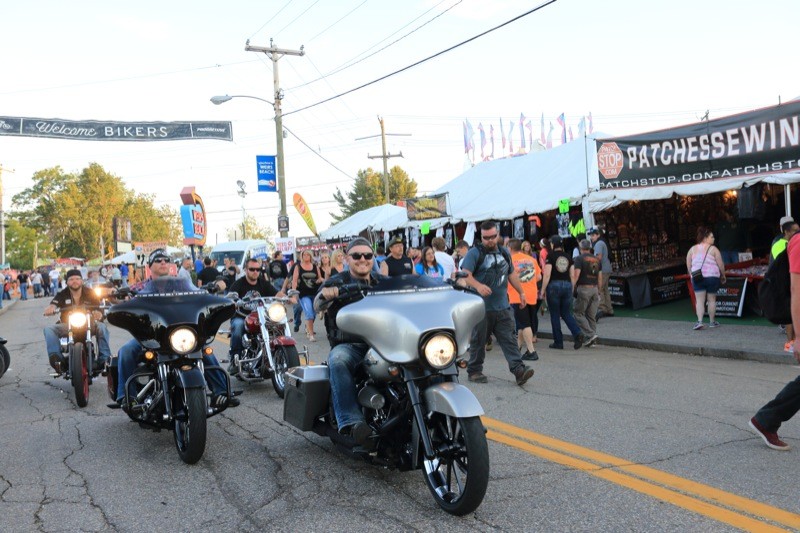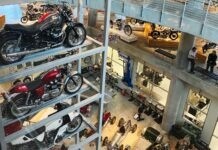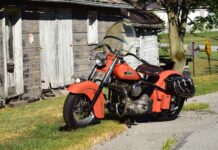Laconia, N.H., June 11–19—Let me be brutally honest: times have changed. Decades ago rallies were about the only way a rider could meet up with like-minded individuals and share a lifestyle that wasn’t generally accepted and events like Laconia Motorcycle Week were few and far between. Certain rally events—the hillclimb, motorcycle races, beer tents, merchandise vendors, charity rides—have gone through changes, yet struggle because they are no longer unique in this highly competitive world. The phrase most often overheard in conversation this year was, “It wasn’t like this years ago.” While we might lament those historic years when riding anything other than a Harley was almost a sacrilege and the Weirs was dominated mostly by men wearing leather or cutoff denim, we can also look beyond the carnival-like atmosphere and see more women riders and a diversity of brands and riding styles. We no longer ride alone, as my left arm, tired from waving, attests. The challenge for Laconia Bike Week—and all major rallies—is to remain relevant and make changes without losing the soul of what they represent.

The 93rd annual Laconia Motorcycle Week started with weather that was cold and exceptionally windy. The first day of “motorcycles only” on the Mt. Washington Auto Road was canceled because the high temperature was only 38 degrees, the wind speed reached 101 mph, and over an inch of snow fell. However, there were so many organized rides taking place during Motorcycle Week that it was difficult to keep track of them all. The 10th annual Peter Makris Memorial Ride kicked off the week on Saturday, as did the 138 Kilts & Colors Ride. The Seacoast & Bentley’s Ride and the Ladies Ride hosted by the Winnipesaukee H.O.G. chapter, the Mae-West Memorial Ride for the NH Humane Society, the annual POW/MIA Freedom Ride, the Moonlight Madness, and 6th annual Jesus Ride, and, of course, several Gypsy Tours kept people on New Hampshire roads and thinned out the normal crowds at the main rally locations.

A small group of women riders from Orlando may be relatively new to motorcycling, but they certainly are accomplished at promotion. The Iron Lilies came to Laconia—three of them actually rode on the epic journey from central Florida to New Hampshire—to participate in Bike Week. I met up with them as they prepared for their charity ride on a rather chilly Monday morning at Laconia H-D in Meredith. Some wore loafers (without socks) and thin leather jackets for their ride into the White Mountains, but fortunately had several properly-attired riders accompanying them. I mentioned that it had snowed the previous week and offered to loan one Lily some socks and a pair of gloves, but no, they would be fine. None of them had ridden on twisty mountain roads, but thanks to local support they were being professionally briefed and led. Ah, the fresh self-confidence of new riders brings a smile to my face. Fourteen Harleys departed for this charity ride on some of the state’s most popular roads and I expect for these Floridians it will prove to be an exciting adventure soon posted on social media.
The Gypsy Tour and motorcycle racing are the historic core of Bike Week. When the races moved from the Gunstock Recreation Area to the Bryar Motorsport Park in 1964, riders migrated down Route 106 to Loudon. After it was transformed into the speedway in 1990, crowds tended to remain at Weirs Beach and a surge in vendor merchandising resulted.

One does not require a crystal ball to look into the future. The Funspot rally activities are no more—and the same for across the road—thus leaving the Broken Spoke as an oasis in the wilderness. Despite an impressive collection of used bikes for sale, all but three of the vendors in Laconia H-D’s parking lot were hawking accessories and carnival trinkets, and only four parts vendors filled the upper lot between Laconia H-D and Hart’s Turkey Farm (perhaps because this is the first year Meredith has levied vendor fees). The Weirs wasn’t crowded until the heat arrived on Thursday afternoon and throughout the week there seemed to be as many cars as motorcycles traversing Route 3. Manufacturer demo rides—Harley-Davidson, Indian, Yamaha, Can-Am, Ducati, and the Polaris Slingshot—have moved to one of the massive parking lots at New Hampshire Motor Speedway and are followed by vendors—J&P Cycles, Kuryakyn, S&S, California SideCar, Vance & Hines, and more—in another. In addition to motorcycle racing and music, the site is privately owned and one can say “hasta la vista” to most city ordinances, parking problems and traffic jams.
Of course, a crystal ball—like a cell phone—doesn’t always work and so some things come as a surprise. So it was with the newest headline feature for Bike Week: LaconiaFest. Wednesday night Steven Tyler played to a crowd of perhaps as many as 4,500 fans at the inaugural LaconiaFest. Not that impressive, considering this legendary rock star is a local resident and that a large percentage of the crowd gained admittance for a mere five bucks, despite advance tickets having been sold for $65. However, it is often said that tomorrow is another day—and it was. Thursday morning employees, vendors and security personnel discovered the venue locked, the safe empty, and the promoter long gone.

LaconiaFest’s problems began a month earlier when promoters estimated that crowds of up to 30,000 people would attend—although how they expected to fit that many people in the restricted venue space is beyond my comprehension. Promoters touted that 100 bands would play during the course of the week and city officials had to base security, sanitation and emergency personnel on these numbers—313 police officers and 122 firefighters for Saturday and Sunday alone—and the promoters were responsible for this cost. Attendance on the cold and very windy first weekend of Laconia Bike Week was a very small fraction of what was projected. Monday was worse, despite admittance being free. On Tuesday some really great bands were playing to audiences of less than a dozen people and sometimes only to me.
Security was tight and everyone—everyone except those of us with generic, readily-available press cards—was being patted down for weapons. When asked the reason I was informed it was because knives and alcohol are a dangerous combination. As a matter of record, I would not have placed what I was carrying in a collection box. In fact, two other gentlemen told security where they could place that box and left with their ladies for a more hospitable venue.
Rumors swirled while vendors, the city manager, employees and headliner Bret Michaels worked together to keep the show going and salvage what they could. The turnout was low, yet they managed to bring in enough cash that employees were paid about a quarter of what was owed them. Regardless, it wasn’t enough. Saturday’s performances were canceled and the venue transformed into a parking lot. While I wasn’t able to confirm whether or not the Hell’s Angels were paid for the security they provided, I did overhear that the FBI had been contacted, know that the city took a financial hit of at least a hundred grand, and was privy to an apologetic phone call from the managing partner who was left holding the (empty) bag. It turns out that some bands actually paid to have time on the big stage and how much cash was taken in and how much money is actually owed depends upon who you talk to. My crystal ball remains murky, but I can add two plus two and it doesn’t come out for LaconiaFest returning in 2017.

Wet T-shirt contests tend to be boring. I like boobs, but it takes a bit more than water and thin cotton to make these events entertaining. Those that took place on the Roadhouse stage were an exception, due in large part to the new emcee, Jack Schit. I thought the one on Thursday was the best I’d seen, but then came the Friday show with 13 contestants and two wild “water boys” who had ponied up in a bidding war for the privilege of drenching the ladies. It quickly got out of hand with the first contestant and escalated into near mayhem with water going everywhere, contestants stripping down and grinding to the music. Jack Schit attempted to stream on Periscope while trying to get the girls to put their tops back on—after all, it was a T-shirt contest—and somehow making a vain effort to maintain some sense of procedural order. The crowd loved it.
The mud wrestling taking place in the upper Roadhouse tent was much more tepid. The woman emcee made a sexist comment about only wanting girls because this was about tits and ass. After a couple of matches a guy literally threw himself into the mud pit and with encouragement another stripped down to challenge him. The two muscular guys aggressively went at it and the crowd, which was almost half women, cheered them on. The Wall of Death and the Burnout Pit were also new additions to the upper tent.

Bar girls had more skin covered than some of their customers, while an incredible airbrush painter named Sean Avram created fantasy art on gorgeous canvases that wore almost nothing at all. The Flaunt Girls flaunted their new line of clothing and leather corsets were the fashion statement of this year’s rally, but honestly the wild days of a couple decades ago are over. People with baby strollers, leashed dogs, leashed children, dogs in strollers, and knee-high toddlers moved through the crowd. At the Progressive Insurance tent, women were having their nails manicured, men their boots polished, and even I sat down for a beard trim.
To see vintage bikes all one had to do was stop at the American Police Motorcycle Museum. Coupled with restoration projects and acquisitions, this museum is jam-packed with over a hundred interesting bikes and thousands of artifacts. Of special note is one of the few bikes that doesn’t run: a 1904 Thor. The Thor was manufactured by the Aurora Automatic Machine Company and looks like an Indian because they made the engine, carburetor and other components for the Hendee Manufacturing Company until 1906. Built under license, the ultra-rare Thors are as much a part of history as the Indians. And did you know that Harley-Davidson once sold dual-sport bikes? The 1975 MT500 with a Rotax engine and plastic body parts was decades ahead of its time and perhaps is the rarest production Harley. A 1928 Indian (Ace) Four is currently being restored and two Indian tribute bikes built. There also are dozens of antique police bikes—all running—to be studied and admired.

Tradition and relevancy are both important. I don’t need another T-shirt, my glasses cleaned a dozen times, my boots polished at every venue, or jewelry to alter my aura. I come to check out new bike models, meet friends—old and new—and to ride some fantastic touring roads that stretch from the seacoast into the mountains. Times change and perhaps one of the reasons why crowds weren’t as large as in past years is that more people were out riding than partying at the Weirs.




























